This morning we had a nice breakfast in the Edgewater restaurant at the lodge before heading out on our tours. I had noticed on Monday night that there were these big chandeliers throughout the restaurant with bear heads on them.
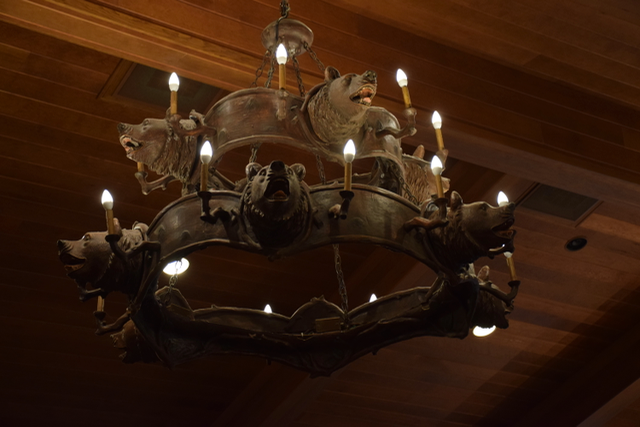
They looked very much like they were made of iron, and this morning I wanted to get a picture. As I was taking the photo, a member of the staff said something like “those are something aren’t they.” I suggested that they really would be something if they fell on someone’s head. She said that for the first three years of her working in the restaurant, she also thought they were made of iron. Then, her manager asked her to help clean them, and she found out they were all made of plastic! Anyway, the breakfast was quite good, and all of us got to try reindeer sausage for the first time (except Sara)!
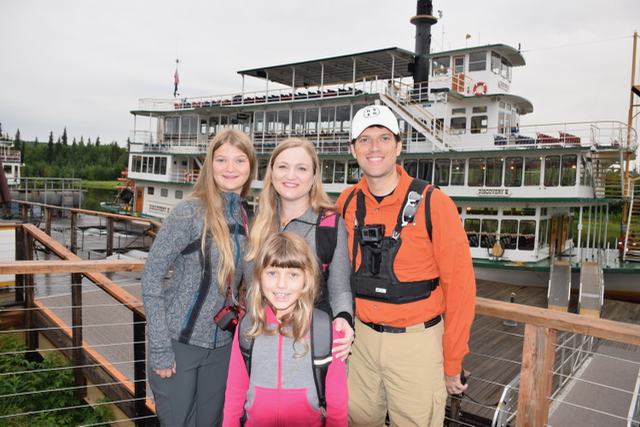
For our first tour of the day, we boarded a coach that took us a few miles down the Chena river to Steamboat Landing. There we boarded a riverboat called the Discover III for a cruise down the Chena River. The riverboat company we were using was founded by Captain Charles M. Binkley over 100 years ago, and his son Jim started the tour company in 1950. His children and grandchildren continue to operate the business today. The Discover III that we sailed on weights 280 tons, and is a true paddlewheel riverboat.

Our guide for the cruise was Jay Lewis, and he was one of the best I have ever seen. He was originally from Maryland, but has been in Alaska for 45 years. During his time as a guide, he has completed over 3,000 cruises. He also said that he works in radio, and his voice would be perfect for a DJ. He was very funny and very informative, and it was obvious how much he loved and cared for Fairbanks.

Along the way he told us a lot about the city of Fairbanks and the state of Alaska. Fairbanks was founded in 1901 by E.T. Barnett, and incorporated in 1903. It is the second largest city in Alaska behind Anchorage, and it sits 1,800 miles south of the North Pole. The average age of the population is 27 1/2, with over half of the residents under the age of 27. The record high temperature is 99º and the record low is -67º. This is the largest gap in temperature extremes in the world. Jay said that one Halloween, he took his kids trick-or-treating when it was -37º. The city only gets around 11 inches of rainfall per year, and the overall climate is like a sub-arctic desert. Even with an average snowfall of 60 inches per year, the snow is so dry that you can’t build a snowman until it starts melting in the summer.
With so little rainfall, the rivers are not fed by rain, but by other rivers and melting glaciers. All of the boats that are docked on the river have steel hulls, so none of them have to be dry docked in the winter.
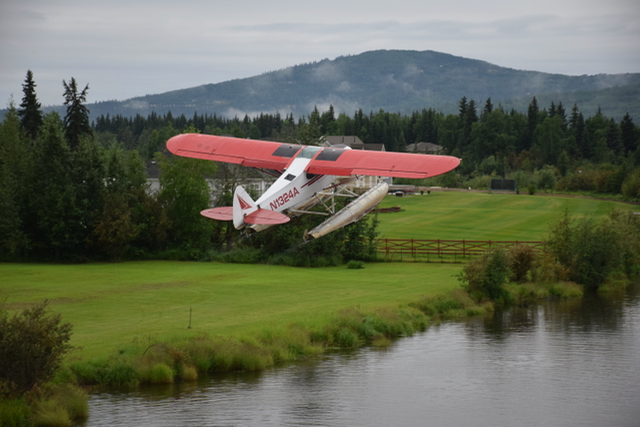
He told us that Alaska has 3 million lakes and a total population of 750,000. Of these, 1 in 78 have a pilots license, which is the highest per capita in the world. With this in mind, one of the first things we got to see on the cruise was a float plane take off, land, and then take off again. Papa, Olivia, and Sara are supposed to fly on a float plane in Juneau while Kate and I are glacier hiking.

The scenery along the river was stunning, and we got to see a lot of neat things on our way to the place where the Chena river meets the Tanana river, which is the largest glacier fed river in the world. While we didn’t get out, the boat stoped by the Trailbreaker Kennel, which was started by 4-time Iditarod champion Susan Butcher. Her daughter, Tekla Monson, talked to us about raising the husky sled dogs, and then did a demonstration with the dogs pulling an ATV around a small lake. All of this was surprisingly easy to see from the boat.

Next we pulled up alongside the Chena Indian Village and were able to see Reindeer and Caribou. We learned that the name “Caribou” literally means “the shoveler,” because they use their hooves to claw through the winter snow to find food. There are 32 different herds of Caribou in Alaska with a population of over 500,000, and even the female have antlers. Then we got to see a demonstration on the wheel used to catch salmon and how they are prepared. Nothing is wasted in the preparation.
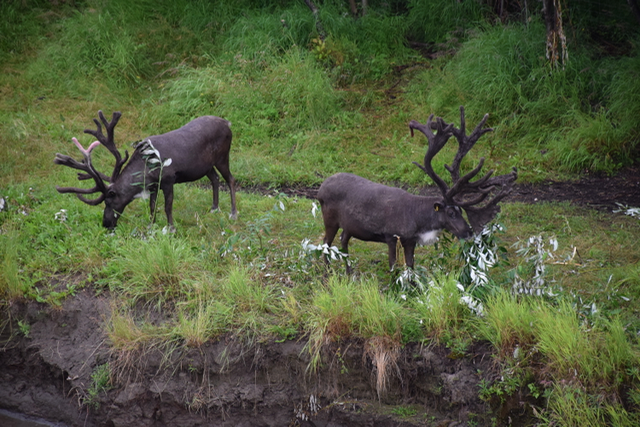
After turning around at the Tanana river, we stopped again a the Chena Indian Village, but this time we were able to get out. It is a recreation of the Little Chena Village, and we got to see several demonstrations about life for the native Athabascan people in Alaska. These demonstrations covered their dress, pre-western contact survival in tents made of caribou fur, and post-western contact survival in cabins.

One of the garments we got to see was a parka made of muskrat fur with a wolverine fur lined hood. It weighed 13 lbs, was designed to withstand up to -40º temperatures, and has been appraised at $18,000. The back of the parka shows the tribal heritage of the wearer. It was awesome.

During the cabin demonstration, we saw cabins made of spruce logs that were checked with moss to seal the gaps. The roofs all were covered with sod, which was also used to seal them. There was one cabin that was built on stilts, and this was to protect pelts and food from snow and animals. We saw pelts from a wolf, wolverine, mink, and several variety of foxes.
For the pre-western contact demonstration, we saw a caribou fur tent, snow shoes, and several things made out of birch tree bark, which is naturally waterproof. This included a baby basket that essentially functioned as a diaper and a birch bark covered boat.
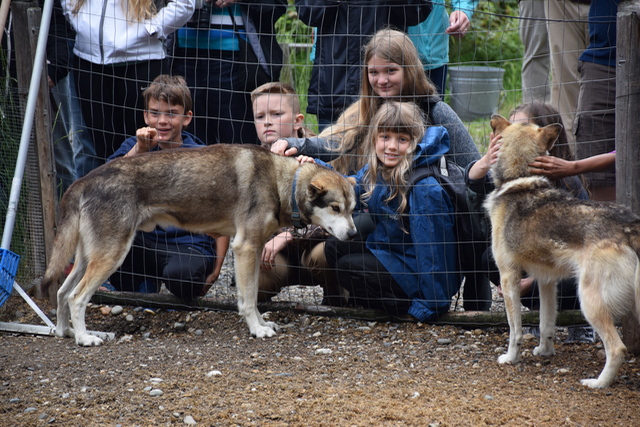
After the demonstrations, we had some free time to explore the village. We took Kate and Sara to see the sled dogs, and they were even able to pet them for a while. Chase from the Trailbreaker Kennel talked to us about the dogs, and what competing in races is like.

Before getting back on the boat, we went to the Post Office where we met Tekla Monson (Susan Butcher’s daughter), and got her to sign a children’s book written by her mother about the sled dog Granite.
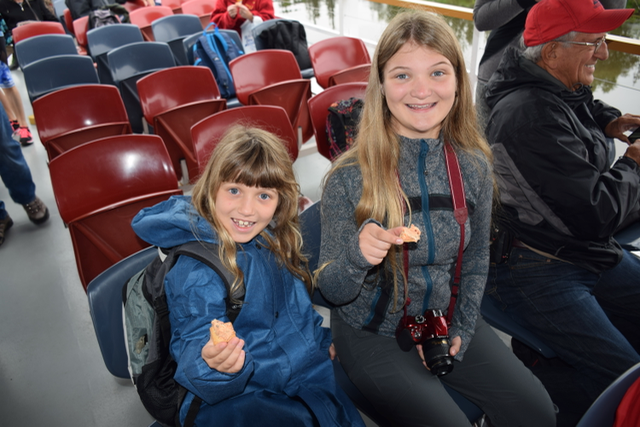
Back on the boat, we all got to try smoked salmon, and even Kate and Sara ate some. Kate went back for seconds! Back at Steamboat landing, we had a great lunch of Miner’s Stew and vegetables, and then had a little free time to explore.
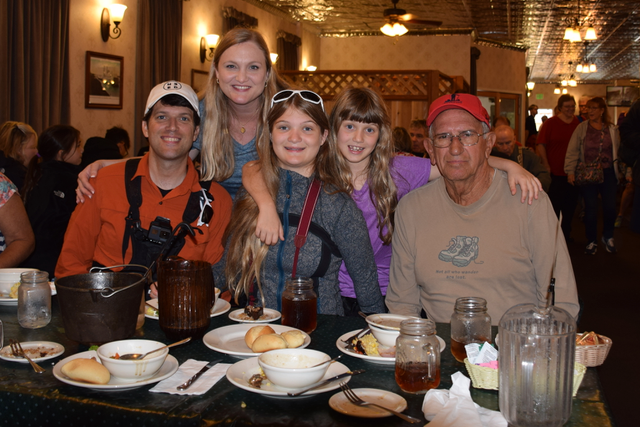
We tried out the “40 Below” room, even though the temps were really only around 20 below. It was really cold, but not too bad for a minute or two.
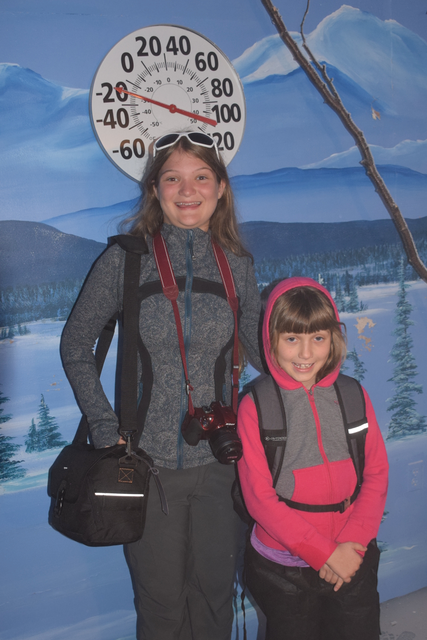
Back on the coach, our driver Courtney told us a number of other things about Fairbanks on our way to Gold Dredge No. 8 for the afternoon. She talked about the “land of the midnight sun,” which we are in right now. Even though the sun sets around midnight, it doesn’t actually get dark from May to August. The longest day is June 21, with the sun up for over 20 hours. From June 21 to December 21, Fairbanks loses 7 mins of daytime every day, and from December 21 to June 21, they gain 7 mins per day.
She said that Summer solstice (June 21) is bigger deal than July 4th, because they don’t have any fireworks with no darkness. On Summer Solstice, they have a baseball game that starts at 10:30pm with only natural light. Fairbanks is right in the middle of Alaska and is known as the Golden Heart City. The gold rush brought people to Fairbanks, and today it has a population of 30,000 in the city, and 100,000 in the larger borough. However, the borough is the size of New Jersey.
On the drive we saw the northernmost Walmart in world with yellow posts throughout the parking lot. All of these were electrical outlets. All cars have electric heaters to help them start in winter, and they wouldn’t be able to start without them. Before the days of heavy machinery it was too cold in winter to dig graves so they had to store bodies until summer. They don’t salt the roads in Fairbanks, but use sand and gravel to increase traction for driving.
As we got near the gold dredge, she told us about the founding of Fairbanks. E.T. Barnett was sailing up the Chena River on a riverboat, and was kicked off the ship near where Fairbanks is today. He met Felix Pedro who had been prospecting for gold. The two of them actually sent out word that gold had been found in 1901, but it was not actually found until 1902 by Felix Pedro. E.T. Barnett was the first may of Fairbanks, which was named for Illinois senator Charles Fairbanks. He eventually became the VP to Franklin Roosevelt.
E.T. Barnett eventually became a banker and began defrauding people. He and his wife had to flee Fairbanks in middle of night on a dog sled. The gold rush brought the people to Fairbanks, but eventually went bust. This was replaced by gold dredging in the 1920s, but this eventually went bust as well. The next major driver of population in Fairbanks was World War II. During that time the number of soldiers in Fairbanks increased from 1,200 to 150,000, and many of these families stayed after the war. Today the biggest driver of the Fairbanks and Alaskan economy is the Alaska pipeline. This year marks the 40th anniversary of the pipeline which was completed in 1977 and is over 800 miles long.

We arrived at Gold Dredge No. 8, which was located in Fox, Alaska. Before taking an open-air train to the dredge, we got to see a section of the Alaska Pipeline and a brief presentation from our guide Tim on its construction and operation. Half of the length of the pipeline is built above ground and the rest below ground. It was built from 1973 to 1977, and the above-ground portions sit on vertical support members (VSMs). These are H-shaped supports that hold the pipeline above the permafrost to keep it stable. Permafrost is land that never thaws. The pipeline is actually not bolted to these supports, but can glide back an forth in case of earthquake. It was built to withstand up to an 8.5 magnitude quake, and the largest every on record was a 7.9 in 2002 from the Denali Fault.
When we first arrived at the pipeline, we noticed that there was a sign that said “Alyeska Pipeline,” and it turns out that “Alyeska” is a native Indian word that means great or main land. “Alyeska” is the name of the company that helps to maintain the pipeline. We learned about “pigs” that are used to perform maintenance on the line. Scraper pigs are used to clean sludge that builds up in the pipeline. They are inserted and removed at pump stations, and pressure pushed them through. When oil passes through the pipeline, it makes no sound, but these scrapers sound like an upset pig when they pass through, and this is where the name came from.
There are also smart pigs that are sent through the analyze the pipe and perform maintenance. The visible part of the pipeline above ground is actually not the pipeline, but the sheath to protect the pipeline. Over 70% of Alaska’s revenue comes from the oil transported by the pipeline.

After the pipeline, we boarded an open-air train to Gold Dredge No. 8. Along the way, Tim explained about all the different ways in which gold has been mined and dredged throughout the years. The valley we were traveling through was originally 150 feet higher than it is today due to all the dredging that took place.

Gold Dredge No. 8 was built in the 1920s in San Francisco and moved to Fairbanks via barge and trains. Ultimately, the dredge is designed to ingest rocks and produce gold bars that weighed 58 lbs. The dredge was HUGE, but it only took six men to run the whole thing. As gold bars were produced, they were stamped with an address, and mailed to the mint in San Francisco. Not a single one was ever lost.

We also learned about he technique of panning for gold. The phrase “flash in the pan” came from finding gold in your pan after washing away the rocks and dirt. And the phrase “didn’t pan out” came from not finding any gold. Once the train stoped, we all got a chance to try our hand at panning for gold. It was a little difficult, but eventually all of us were able to find a little gold. Olivia and Papa didn’t have theirs weighed, but I found $24 worth, Sara $18 worth, and Kate $12 worth.

After panning, we were able to explore the inside of the dredge and had some yummy cookies and hot chocolate in the gift shop. Also in the gift shop, Kate and Sara both gold to hold a $75,000 gold nugget, which is the largest nugget ever found in Alaska.
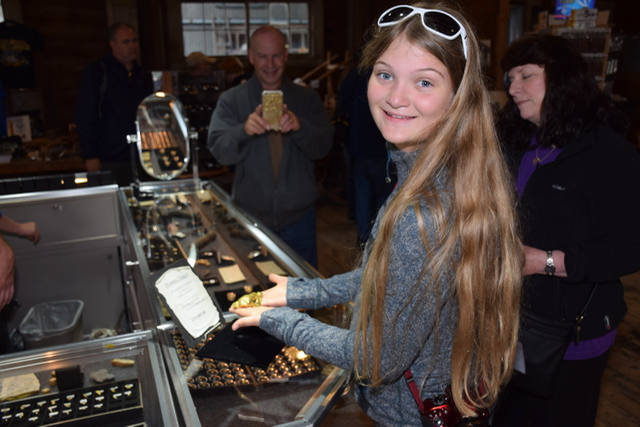
As we left on the train, Tim told us that there is still a lot of gold in the valley, but they don’t dredge today due to regulation (OSHA, EPA, etc.) and from the dangers involved in dredging.
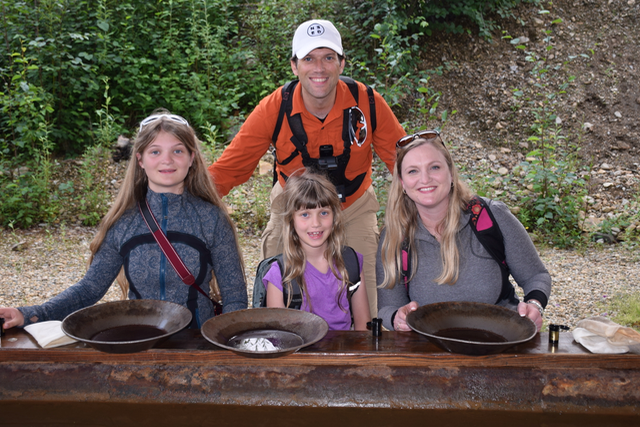
After arriving back at the lodge, we boarded a shuttle for downtown Fairbanks. We walked around a lot and had a nice dinner at Lavelle’s Bistro.
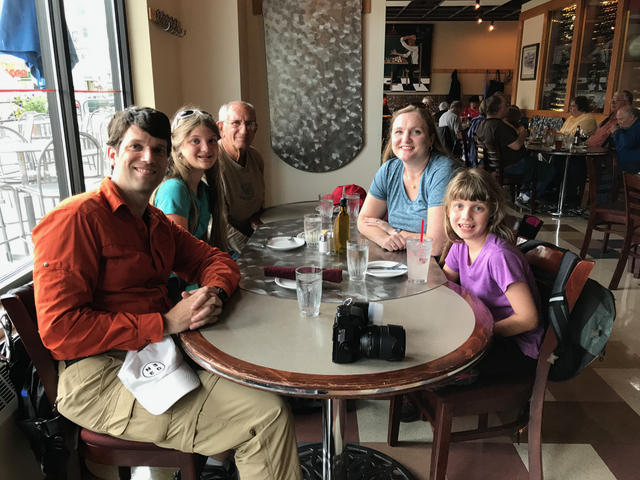
This was an awesome day, and the weather ended up being fantastic. It was cloudy, but there was no rain and the temps were in the 60s for most of the day.
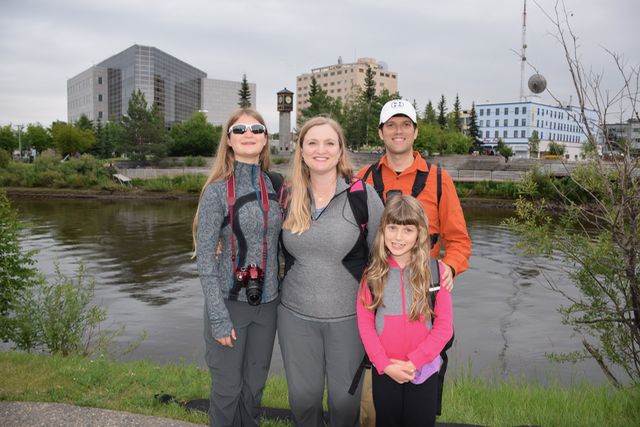
Tomorrow we head to Denali in the morning for more adventures!
